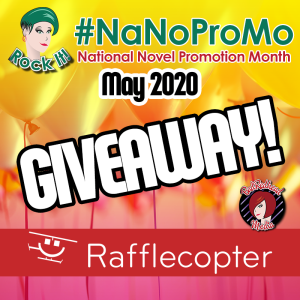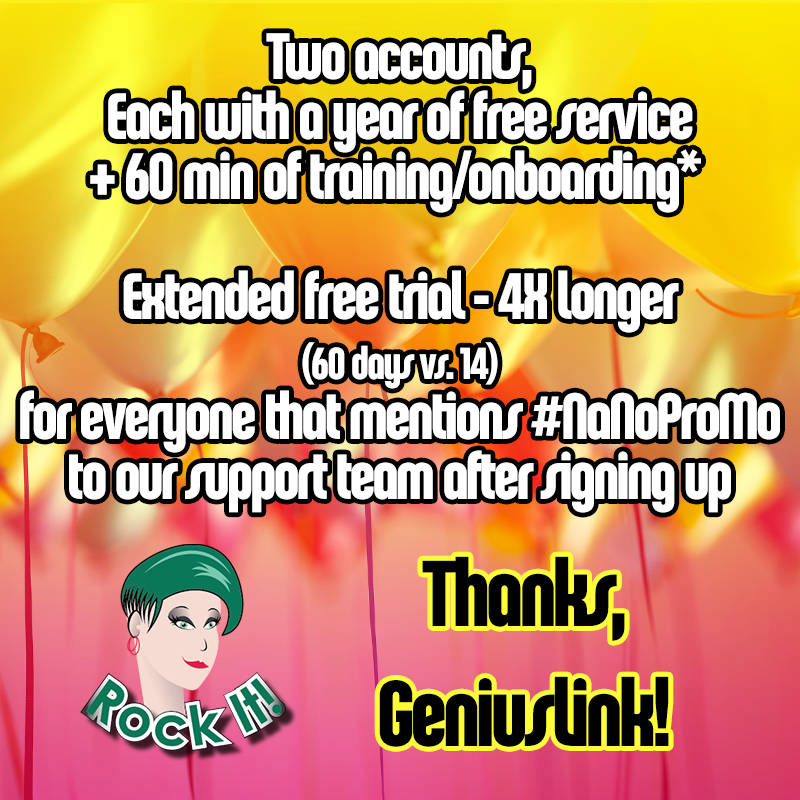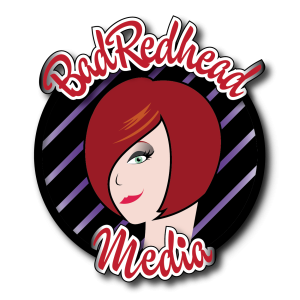How to Use Amazon’s Affiliate Program to Energize Your Marketing by Guest @GeniusLink
While every author is familiar with Amazon and Kindle, many aren’t familiar with Amazon’s affiliate program, officially known as Amazon Associates. Becoming familiar with the Amazon affiliate program is an important way to get insights into your own marketing, and can help you earn some additional money for promoting your books.
Sounds amazing, right?
What is the Amazon Affiliate Program?
Before we dive into why you should be using the Amazon affiliate program, we should probably step back and explain what it is. And more importantly, why authors, in particular, should be using it.
The Amazon Affiliate Program (aka the “Amazon Associates” Program) is a marketing program Amazon runs that rewards you for referring shoppers to Amazon, with a percentage of what they buy, whether it’s the product you recommended (your book) or something else entirely (a new TV).
As authors, especially those with their books for sale on Amazon (which is pretty much every author ever), Amazon’s affiliate program can be beneficial in two ways.
- First, it gives you a way to make some money for something you are already doing – promoting your books on Amazon.
- Second, with some organization and a little work, the Amazon affiliate program can unlock lots of insights into how your promotion efforts are actually working and which marketing channels are most effective for you.
Money for Nothing
The Amazon affiliate program is an easy way to earn additional money for something you are already doing.
Every time you tweet out a book recommendation, for your book or even for others, you might want to use an Amazon affiliate link instead of just the link you took directly out of your browser. When people click on an affiliate link and buy something from Amazon (within 24 hours), even if it’s not your book, you earn a percentage of that sale.
To get started you need to sign up for Amazon’s affiliate program, which can be done in about 20 minutes, starting with the big yellow button here: https://affiliate-program.amazon.com. Remember that any of the questions they ask on the intake form can be updated later so don’t worry too much about the questions you don’t yet understand or don’t have a game plan for.
The payout rates vary but you are looking at commissions between 4 to 4.5% for books. However, commissions can be as high as 8 to 10% in some categories.
The interesting part is that even if the reader doesn’t buy your book, but buys something else, you still earn a commission. We call these “halo commissions,” and it’s one of the things that makes Amazon’s program good to get started with.
Amazon pays out commissions approximately 60 days after the month closes, and can pay them to pretty much anywhere in the world via direct deposit or check. You can also get a gift card for the balance if you prefer.
While you probably won’t get rich off of your affiliate commissions, they can add up. We recommend you use this new money as the start of your marketing fund for the launch of your next book.
THRU MAY 15
Enter this massive Rafflecopter giveaway!
 Click Here for the Rafflecopter Giveaway
Click Here for the Rafflecopter Giveaway
Better Information Equals Better Marketing
The second major benefit from the Associate’s Program is from the tracking that Amazon provides with their affiliate program. The gist is that with some organization on your part, the reporting for the affiliate program can tell you what products were sold with your affiliate links.
While you may get some aggregate sales data directly from Amazon or your publisher, I bet they can’t tell if your blog or the links in your tweets sold more books (a.k.a. your marketing channels). Well, with a few minutes of work you can see which of your marketing endeavors actually leads to sales of your books! It takes a little work to set up a system to stay organized but can be a super powerful tool for your marketing.
Let me explain:
As part of the way the Amazon affiliate program works, Amazon provides reports on your commissions and on what products were sold via the referrals you made from your links.
A little digging into this report allows you to see how many of your books you were directly responsible for selling.
But, to really make this even more interesting, Amazon allows you to create up to 100 unique “tracking IDs.” And for each of these tracking IDs, you can filter your report to show just what was sold with them.
So, for those of you that enjoy a little organizational fun, you can create a handful of unique tracking IDs, then individually add them to the Amazon link for what you are promoting, and then assign each of these new affiliate links to different marketing projects.
For example, you could use the tracking ID “twitterABC-20” could be for all of the links you share on Twitter while tracking ID “mysiteMNO-20” could be for your website, and finally “facebookXYZ-20” could be for all of the links you share on Facebook.
This is much easier when you create a simple spreadsheet to organize your links and the tracking codes you are using with each. You can then use this cheatsheet every time you are ready to share a link. A good universal link management tool makes this even easier.
After you have created your links and shared them it’s time to dig in and see what actually worked. The Amazon affiliate dashboard lets you filter your reporting by each tag so you can see exactly how many clicks and the commissions you got, but more importantly, you can see the specific items that were sold via the links you were using.
So as long as you were deliberate in where you used the link you can finally get some very specific insights into your marketing efforts and start to get answers to scenarios like this:
- Is Twitter or Facebook a better place to recommend my book?
- Is my blog or guest posts on other websites better?
- Do I sell more books when I ask for reviews or when I give away a free chapter?
Using the Amazon affiliate program is one of the few windows into the black box that is Amazon and, when done correctly, can help you decide which marketing channels make sense for you to focus on and which ones aren’t actually leading to book sales so you can focus your time and money on the things that work.
More information about how to use the Amazon affiliate program to provide deeper insights into your marketing are outlined in this blog: Tracking Sales Within Amazon.
What’s the Catch?
The only real “catch” is that you have to play by Amazon’s rules or you risk getting your affiliate account closed (but I’m sure you all are probably already very familiar with playing by Amazon’s rules)!
Amazon has a lot of rules, and we’ve written extensively about them in our blog. We’ll review a few of the most relevant ones for authors in a moment but two resources you might like to review are:
Amazon Associates – The Ultimate Guide To Getting Your Account Banned
How to Share Amazon Affiliate Links on Social Media
01 Can’t share affiliate links in email!
Amazon doesn’t allow links to be used in an “offline” manner and yes, they consider email to be offline.
02 Can’t share affiliate links in your ebook!
Again, Amazon doesn’t allow “offline” links. This also includes PDFs or chatbots.
03 Don’t ask people to click or bookmark your affiliate links!
Amazon doesn’t like any “incentivized” behavior concerning your affiliate links.
04No posting affiliate links in private groups!
When posting on social media, your links need to be publicly available.
05 No affiliate links in paid ads!
Unfortunately, you can’t use an affiliate link inside of an ad (via social media or other). Bummer because the tracking they provide would have been super helpful!
06 You must include affiliate disclosures!
The FTC requires any sort of affiliate link includes a disclaimer acknowledging the financial possibilities. #ad works but #affiliatelink does not. Further, Amazon requires you to include a short, pre-defined sentence describing your relationship with them to be placed in your social media account profile or your about us page on your site. Sorry, it’s the rules!
07 Let Amazon know where you are placing links!
The FTC requires any sort of affiliate link includes a disclaimer acknowledging the financial possibilities. #ad works but #affiliatelink does not. Further, Amazon requires you to include a short, pre-defined sentence describing your relationship with them to be placed in your social media account profile or your about us page on your site. Sorry, it’s the rules!
Finally, it’s also important to note that Amazon’s affiliate program is free to sign up with and use! To stay active you need to make three sales within every 180 days and the minimum threshold for payments is ~ $10 in affiliate commissions.
Best Affiliate Practices and Optimizations
The more often you use an affiliate link in your marketing the more likely you are to get clicks. So, as long as you aren’t violating Amazon’s Operating Agreement or program policies you should use an affiliate link every chance you get.
It’s also important to note that “Amazon’s Affiliate Program” is actually a collection of affiliate programs that are storefront-specific and independent. E.g., the Amazon.com affiliate program is separate from the Amazon.ca affiliate program, etc. Further, each affiliate program pays commissions from sales in a specific storefront. Therefore if you have a fairly diverse and international audience be sure to sign up for the various Amazon affiliate programs in your top countries.
Universal links (an Amazon link that works with the many international Amazon stores) combined with Amazon’s affiliate programs can be a powerful combination. We, of course, are huge fans of this as we (Geniuslink) provide one of the premier universal linking tools for exactly this!
To be able to drive traffic and sales from emails, ebooks, PDFs, etc., you could link to your website or a landing page. From there you can place the affiliate link, as your website/landing page is not “offline” as forbidden by the Amazon affiliate rules.
Alternatively, many authors use the Geniuslink “Choice Pages” for marketing across these “offline” channels as the landing page is online and optimized to help you make that sale.
Also, to minimize the number of disclosures you need to add to your social media posts or profiles, you might also want to consider a Choice Page that includes a built-in FTC and Amazon disclosure.
Conclusion
The Amazon Affiliate program provides the short term benefit of opening up another way to make money for something you are already doing but can also unlock a treasure trove of information about your marketing efforts and marketing channels by using specific affiliate links in each of your marketing endeavors. A little bit of organization and work can go a long way into helping you determine where you should focus your efforts for the best return and which tasks have been wasting your time.
Good luck and don’t hesitate to reach out with questions and success stories. You can find us on Twitter with @Geniuslink or ping us directly via our website.
THE GIVEAWAY
I’m guessing earning some extra money from sharing links sounds interesting but does figuring out which marketing channel works really get you excited?
If so, then leave a comment below and two of you will win a year’s free access to Geniuslink so you can track all of your marketing channels and build as many Choice Pages as you can. The winners will also get an hour of onboarding from the Geniuslink team to ensure they are getting the most of their access.



Want to win this giveaway? Simply leave a comment WHY below!
All comments must be left prior to midnight on Thursday, May 7th, 2020 in order to be eligible to win. Winners for the week announced on Friday, May 8th.
Good luck!
Jesse Lakes | geniuslink
Jesse is a Native Montanan and the co-founder and CEO of Geniuslink – or, as he likes to say, head cheerleader. Before Jesse co-founded Geniuslink, he was a whitewater rafting guide, worked at a sushi restaurant, a skate/snowboard shop, was a professional student, and then became the first Global Manager at Apple for the iTunes Affiliate Program. Outside of the office, Jesse enjoys taking his family on adventures and firmly believes that “time you enjoy wasting is not wasted time.”
For a more detailed plan on developing your book marketing, purchase Rachel’s new book,
The BadRedhead Media 30-Day Book Marketing Challenge
Now on Amazon!
Readers’ Favorite Silver Award Winner!
Have you signed up for my newsletter yet?




As far as the e-mail links go – I had a problem when I accidentally included them in my automatic blogpost-notification e-mails.
I had the feed for the e-mail set to show up to the first jump break on the page whenever I posted a new blogpost… which I didn’t realise sometimes included the first of my Amazon links. When Amazon caught on, I had to figure out what was going on & fix it. (I had a notice saying I broke their rules by e-mailing links, and I’m like… no?! I haven’t?! – and had to work out what e-mails it could be referring to.)
Now I’ve set it so that I only e-mail the blogpost title in my notifications – which isn’t ideal, but means I won’t accidentally break their rules again.
I didn’t know about this, thank you so much! I’m going to set up an account and have a play around to see what I can do.
I have been meaning to look into Amazon affiliate links for some time now! This post is the perfect incentive to go ahead and set things up!
Thanks for sharing, that is something that I have to say, I had never heard of before. One of the most frustrating things about advertising is that it’s hard to know what is working.
Thank you for some interesting information that I hope to use in the future.
Great article. You cover all bases when it comes to what the program does. I’ve been a affiliate member twice but got the boot both times due to lack of getting sales. I do like the idea I guess I just stink at getting people to click on the links.
Thanks, Jesse. You explain the rules so much clearer than Amazon does.
As a first-time author, this is a new world to me so it’s nice to read expert knowledge. I’ll be rereading this (and reading the links) in the coming weeks. Thanks for the timely advice!